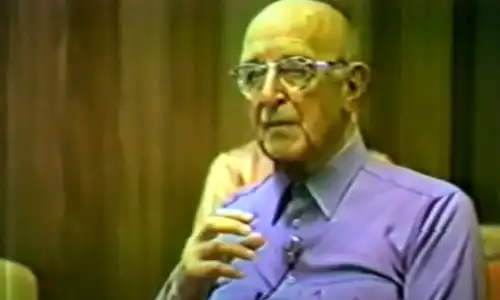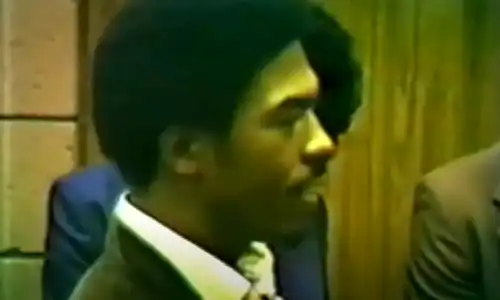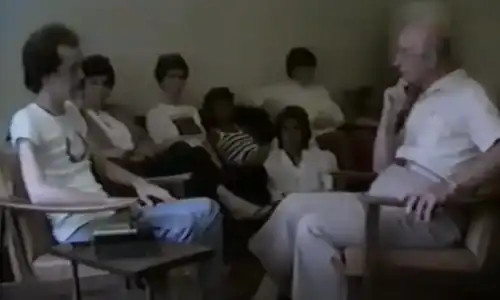THE PSYCHOTHERAPY OF CARL ROGERS:
PRESENCE
BY WILL STILLWELL
PRESENCE

Presence – an idea that’s become more pronounced in the last one hundred years, and which has retained a wide variety of connotations. Presence is “being called into being by another being.” In his explorations of therapeutic dialogue, Peter Schmid((*Schmid, P., (2002) “Presence: Im-mediate co-experiencing and co-responding” www.pca-online.net #51))relates a person’s presence to her integral immediacy, to her quality of confidently taking part in the present moment. And, I would add, her being “Here, with me.”((Others, including Rogers himself, have commented on Rogers’ way of being present. See for example:
*G. Lietaer, R. Rombauts and R. Van Balen, eds., (1990) Client-Centered and Experiential Psychotherapy in the Nineties;
*Rice, P., (after 1979) ms. “The process of presence in person-centered psychotherapy”;
*Seeman, J., (2002) “Looking back, looking ahead: a synthesis” in Cain, D., and J. Seeman, eds., Humanisitic Psychotherapies: Handbook of Research and Practice;
*Stillwell, W. (1990) Primal Presence))
For presence is a spatial concept, an iconic marking by locating being in an extension of time. 1 Presence is an idea or experience with deep roots in Western society. Presence is truth unconcealed and embodied more than truth believed as an idea. It is allied to our culture’s primordial premise “being” – which is how we frame a world of existence. “Presence pervaded with absence”, observes philosopher Mark Taylor,((*Taylor, M. (1987) Erring)) is a constant theme for all of Western history. Presence of God – conceived as “Being” Himself, and an ultimate, coherent That Which Is((*Buber, M., 1958 Moses)) – is one of our civilization’s long-term primary concerns. God is the ultimate unconditional loving Other, but does God continue presence among us? His questing people often find Him absent — Nothing. This cultural perplexity and ambivalence informs our experiences of being-here in our lives.
Realization of lack of presence between us — what he called ‘mis-meetings’ – inspired the work of another philosopher and theologian, Martin Buber. Buber said even as God remains invisible He is calling to each of us, “Where are you?” Our faithful answer would be, “Here I am, responsible to you.”((*Buber, M., 1955 The Life of Dialogue)) For Buber, God’s presence manifests where one person truly turns to meet another. “I become I in my uniqueness” where I am met in full moral responsibility by another. Carl Rogers was strongly attracted to and influenced by Buber’s thinking, and made key secular appropriations from Buber’s sense of full meeting with Other. With Buber as a reference, in some essential ways Rogers’ practice with these clients embodies a “two-person psychology”
Clients seek psychotherapy, Rogers understands, because they sense their own crisis in a kind of separation or alienation from living: cut off somehow from life in other beings but especially apart from the vivacity within themselves. The client’s ideas, beliefs and hopes of who he is do not harmonize into coherence with his life experiences. He may have a sense that he lives falsely, his daily actions seeming absent of his real self. His absence or avoidance does not allow him to be here present. Rogers’ manner of being himself with a client, he believes, helps the client realize his or her own ethical presence.
The four psychotherapeutic interviews of our focus are first-interview demonstration meetings of these volunteer clients and Rogers in his final six years of life. They are presentations before mostly appreciative audiences in service to the individual clients and to audience learning.

At this time Rogers liked this format for his client-centered work. At some point in each recording, each of the clients notes awareness of himself and of the audience.

Steve grapples with his relations to himself and others that seem to both connect and alienate him. He moves from what he calls his ‘intellectualizations’ to his deep pain.

Dadisi arrives determined to find his own way and achieve rewards appropriate to his abilities. He brings forward his distrust of Rogers.

Both Richie and Philip come to experience their respective interviews as microcosms of their presenting concerns. Richie presents self-doubt as to his competences, and Philip pursues his own maturity through handling his deep feelings. Each of the clients seems intent to “pull himself together:” to attain greater awareness, influence over his own life happenings, to gain ethical clarity and order.
Before he starts an interview, Rogers asks himself,“Can I really be present?” Perhaps, as well, Rogers’ intention of responsivity for himself is what Rogers’ clients seek for themselves.
I have long-liked how Rogers’ therapist colleague Norman Chambers frames the therapeutic invitation: “Welcome to the dance.” Perhaps the therapist will be a partner you can trust to accompany you, a person who will not cut you off (or step on your toes), one with whom you may trust your own experiences. The “dance” to me brings associations of Rogers’ terms “organismic wisdom” and “organismic functioning”: movement in rhythmic, coordinated relationship.((*Condon, W. 1976 in “An Analysis of Behavioral Organization” Sign Language Studies 13:285-318, and in his films demonstrates normal human living as co-existence, described as predominantly “sustaining…isomorphically-with” behavior.))
The client and Rogers sit face-to-face, body-to-body.((In his earlier career, Rogers was (in)famous for his “tactic” – his arrangement of being in touch – “moving out from behind his desk” with clients.)) This posture allows both Rogers and the client to participate into the living other. Their open embodiment makes easier a kind of rapport, a kind of bringing-self-forward-again – that is the hallmark also of Rogers’ verbal messages to his clients.


“The essence of therapy is the meeting of two persons…freely and acceptingly entering into the world of the other.”((*Rogers, C., 1961 On Becoming a Person)) This is the partnership of presence offered by Carl Rogers. And Rogers says to Philip, “You’re with someone…with someone beside you.”

Clearly in their physical orientation, no one is beside Philip. I believe this is the way Rogers expresses his ideal of himself: partner-as-companion.
- Comparative linguists have suggested that English speakers often designate physical similes, especially dimensions of spatial qualities, in order to make abstract experiences such as “presence” into nouns or things of our world. Extensions and durations are intimately connected in our English understanding of both space and time. “Here” and “now” are terms most often used in tandem where/when referring to presence. It appears also that “moment” and “movement” come from the same language source: both signify “importance” -- that which matters to us. Later, we’ll have a chance to meet what Rogers called, “moments of movement.”
“Postmodern” thinking is said to privilege space over time, as I am doing here, so perhaps I’m finally catching up to thinking postmodern. [↩]
